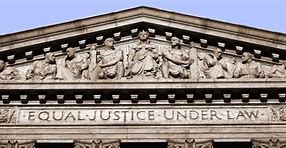Reclaiming Civil Rights
This essay first appeared in Chronicles on October 18, 2024 (here). Thanks to Real Clear Policy (here) and Power Line!
“Civil rights” is one of the most misunderstood terms in law and politics. For that reason, it is also prone to the greatest abuse. In modern parlance, “civil rights” is often used to refer to the legal rights accorded to blacks and other minority groups in order to prevent (or redress) discrimination: “affirmative action,” racial quotas, set asides, racial preferences, and so forth. In that imprecise context, “civil rights” have become a sacrosanct form of racial entitlement, to be challenged by scholars and public figures only at their great peril, as Penn law professor Amy Wax, VDARE’s Peter Brimelow, and American Renaissance’s Jared Taylor (and others) can attest. Challenges to the prevailing orthodoxy of this conception of “civil rights” are aggressively policed by far-left groups such as the Southern Poverty Law Center, and denounced as “hate crimes.” For this reason, conservatives often steer clear of the topic, lest they be falsely branded as a “racist” or “white supremacist.” This has allowed “civil rights” to become an instrument of leftist social engineering—a fever swamp of “anti-racism” and multiculturalism.

Ironically, a more accurate definition of “civil rights” is legal rights which all citizens possess—in essence, equality under the law. Property rights and the freedom to contract are among “true” civil rights. Unfortunately, due to the allure of rent-seeking by various “victim” groups, and the advent of identity politics, nearly everyone is now in a legally “protected” classification, along with blacks, except for physically-healthy heterosexual white men under the age of 40. Incredibly, most citizens qualify for “minority” treatment! Since the passage of the Civil Rights Act of 1964 (Title VII of which covered color, religion, sex, and national origin, in addition to race), Congress has enacted similar protections for those aged 40 and above (the Age Discrimination in Employment Act).
In 1990, President George H.W. Bush demonstrated his “kinder, gentler” bona fides by successfully promoting passage of the amorphous Americans with Disabilities Act, thereby unleashing a torrent of frivolous lawsuits by people claiming to have physical or mental ailments. State law counterparts to these statutes have expanded the scope of “protection” to include sexual orientation, “gender identity,” and other trendy lifestyles. As Alexander Riley noted in Chronicles, “More than 30 kinds of discrimination are currently prohibited in America, including discriminating against people with criminal records, welfare users, and drug addicts.” Special privileges have replaced equal treatment under the law.
Some conservative critics of the current civil rights regime blame the various statutes (or even Brown v. Board of Education) for the havoc that has ensued. The loss of freedom of association resulting from “non-discrimination” mandates predictably leads to conflicts such as the harassment of Colorado baker Jack Phillips (and other Christians) by LGBTQ activists. Alas, the Iron Law of the Beltway is that laws, once adopted by Congress, are never repealed, no matter how wrong-headed or destructive they prove to be. (And Brown is sacred.) But that doesn’t mean that the civil rights swamp can’t be drained—at least to some extent.
Here’s how some of the worst aspects of the civil rights regime could be corrected: The administrative agencies charged with enforcing these laws (mainly the Equal Employment Opportunity Commission, but also including the U.S. Department of Justice and the U.S. Department of Education with respect to Title IX of the Education Amendments of 1972, which prohibits sex discrimination in education by recipients of federal funds) have for decades adopted fanciful interpretations of the various federal statutes, often with the complicity of the courts. This overreaching could be corrected by a President wishing to restore common sense to the subject of civil rights. The demise of Chevron should hasten heightened judicial review of agencies’ dubious interpretation of statutes.
After decades of acquiescence, misdirection, and unforced errors, a courageous cadre of thought leaders on the right are debunking the bogus narrative regarding so-called “civil rights,” and some of our governing institutions are following suit. Last year, for example, in Students for Fair Admissions v. Harvard, the U.S. Supreme Court ended its longstanding, misguided devotion to “diversity” as a rationale for permitting racial preferences in college admissions. The “affirmative action” odyssey that began with Bakke in 1978, and continued with Grutter in 2003 and Fisher II in 2016 ended abruptly in 2023 with the benefit of President Trump’s three originalist appointments to the Court. Racial preferences are now forbidden in higher education, in favor of the color-blindness standard famously advocated by the dissenting Justice Harlan in Plessy v. Ferguson (1896). Moreover, the once-ascendant DEI movement (for “diversity, equity, and inclusion,” a euphemism for identity politics and wokeness generally) is in retreat, in higher education and corporate America. These reforms were merely the low-hanging fruit; more can be done.
As Thomas Powers pointed out in a recent article in The American Mind, and as I argued in Law & Liberty in 2018, the ubiquitous claim of “hostile work environment” sexual harassment is nowhere contained in Title VII of the Civil Rights Act of 1964, which forbids “discrimination” on the basis of sex; an entire body of “law” was never enacted by Congress, but manufactured, in Powers’s words, “by the civil rights bureaucracy and then consecrated by the federal courts and, ultimately, by the Supreme Court.” The EEOC cooked up the radical feminist notion of sexual harassment as a violation of Title VII, which the Supreme Court wrongly endorsed in Meritor Savings Bank v. Vinson (1986). Title VII’s supposed ban on “gender stereotypes” and same-sex sexual harassment are also doctrinal inventions never adopted by Congress. With the Supreme Court’s blessing, the EEOC imposed vicarious liability on employers and mandated sexual harassment training in the workplace. With its new 6-to-3 conservative majority, the Supreme Court could overrule these ill-considered decisions as readily as it banned racial preferences in Students for Fair Admissions.
An even more egregious expansion of Title VII occurred in Griggs v. Duke Power (1971), with the manufacture of the pernicious legal doctrine of “disparate impact,” which presumes intentional discrimination by an employer if any practice, policy, or hiring standard produces a statistical deviation between the composition of the workforce (or any subset thereof) and the population as a whole. Applied to the field of higher education, “disparate impact” would hold that admissions decisions using SAT scores and high school GPAs are presumptively unlawful if blacks are at a disadvantage compared to whites and Asians. Of course, the Supreme Court ruled otherwise last year under the Constitution and Title VI of the Civil Rights Act of 1964.
Federal bureaucrats have used disparate impact in many contexts other than employment—from monitoring arrests to regulating the imposition of discipline in public schools. Griggs should be challenged and overturned. Disparate impact is a lawless contrivance.
Judicial blunders can create public policy debacles, as the Supreme Court did by authorizing forced busing of students to achieve desegregation in the 1971 Swann decision. Decades later, following protracted, bitter controversies across the country, the Roberts Court finally ended the unpopular practice of judicially-supervised racial quotas in public schools, implicitly overruling Swann. Corrections of administrative and judicial mistakes are possible when congressional repeal is not required. In this regard, the Supreme Court’s disastrous 2020 decision in Bostock v. Clayton County, misinterpreting Title VII’s reference to “sex” to include gender identity, sexual orientation, and transgender status, should be corrected to clarify that sex means sex—and nothing more.
Under both Presidents Obama and Biden, federal government agencies have misinterpreted Title IX—which was passed to prevent discrimination against women in higher education—to require recipients of federal funding to allow biological men to have access to women’s bathrooms, locker rooms, and even showers. Obama’s Department of Education (through its Office of Civil Rights) launched an equally destructive campaign to require colleges and universities to adopt one-sided disciplinary codes, administered by academic personnel ill-equipped to handle an adjudicatory proceeding, with the effect of railroading students accused of sexual misconduct. This, in the guise of enforcing Title IX’s prohibition of sex discrimination! The Obama administration also attempted to force American colleges to impose draconian speech codes to prevent any sexually themed remarks that could subjectively offend any listener. The damage of this bureaucratic overreach to our nation’s colleges and universities was incalculable, producing in some cases life-changing miscarriages of justice.
The good news is that, in the event President Trump wins re-election on November 5, many of these abuses could be rectified by executive orders and the appointment of sensible, action-minded department heads in the pertinent federal agencies (particularly the EEOC, DOJ, and DOE) who will rescind misguided policies. Filling future Supreme Court vacancies with sound textualists would facilitate the doctrinal housecleaning that is long overdue.
In order to make America great again, President Trump must make civil rights honest again.

































